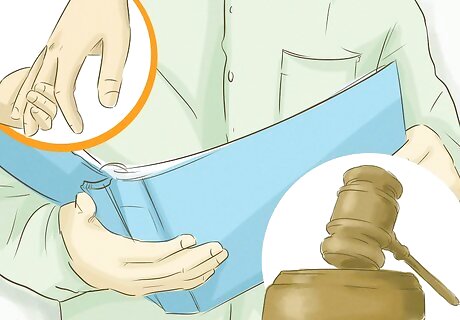
views
X
Research source
Deciding to Become a Legal Guardian

Learn the responsibilities of a legal guardian. Generally, as a legal guardian you have full control over the child's life, just as a parent would. Typically, the child would live with you. You also would have the power to make decisions for the child about life issues such as where she goes to school and whether she goes to church. If the child's parents are no longer living, or if their parental rights have been terminated, you also have full financial responsibility for the child. Otherwise, the parents may owe you child support. Temporary guardians may be appointed in medical emergencies, where a parent is refusing to allow necessary medical treatment for his child. This would be a more limited guardianship in which you would not have the ability to make decisions for the child in other areas of life.

Find out who qualifies to be a legal guardian. At a minimum, a legal guardian must be an adult who has never committed a felony and is physically and mentally capable of fulfilling the responsibilities of guardianship. Courts typically look for guardians who have a genuine interest in the child's welfare. For this reason, close relatives often are preferred as guardians because they have a pre-existing relationship with and connection to the child. Some states have a priority list for choosing a guardian. For example, Texas prioritizes parents first, followed by grandparents, followed by next of kin, followed by a non-relative. If you are further down the priority list, you may have to demonstrate that others of higher priority are either unwilling or unable to serve as guardian. If you are applying to become a full legal guardian, you generally must be able to demonstrate that you are financially capable of caring for the child.

Consider alternatives to full guardianship. There may be other options available that would be less expensive and less final than full legal guardianship. Once you're granted guardianship, that responsibility generally does not end until the child turns 18, unless the child is emancipated or gets married before that age. If the parents' inability to raise the child seems temporary, it may be possible for you to take care of the child without going through formal guardianship proceedings. Some states do have procedures for non-parents to make essential decisions for children. For example, California has a form to allow non-parents to enroll a child in school

Get the required consent. Generally courts only allow guardianship with parental consent, if the parents are still alive. Courts will allow guardianship over the parents' objections in some situations, but this would require you to prove that the parents are unfit. Since courts tend to prefer biological relatives as guardians, if you are not a biological relative of the child, or if there are closer relatives, you may have to notify them and get their consent before pursuing guardianship.

Consider hiring an attorney. Because the laws concerning guardianship are complicated and the life of a child hangs in the balance, you should consider talking to an attorney who has experience filing petitions for legal guardianship. If you don't think you can afford to hire an attorney, search for free or low-cost options such as legal aid organizations or law school clinics.
Completing a Petition for Guardianship

Figure out which court you need to use. Guardianship cases typically are heard in probate or juvenile courts. Generally, you need to file a petition in the appropriate court in the county where the child lives.

Find the appropriate forms. Most courts have forms available for print or download online. You also can get the forms from the clerk's office, although you may be charged a small fee for them.

Gather the necessary information. To fill out the petition and related forms to ask the court for guardianship, you will need information such as financial and employment information. Look over the forms first and make a list of the information you'll need so you can gather it all before you begin.

Fill out the forms with the information requested. The forms you'll have to fill out will vary among states and also depending on whether the child's parents are still alive. Every state requires a petition, which is the form you use to ask the court to appoint you guardian of the child. You'll need to include your name along with your spouse's name if you are married, your address and phone number, and other information such as your relationship to the child and why you are requesting guardianship. You will need to attach affidavits, depending on the child's living situation and why you are requesting guardianship. For example, if the child is living in an intolerable situation and you want to remove the child from that setting, you probably will have to attach an affidavit to your petition that describes those facts. A Declaration will be required if your state has adopted the Uniform Child Custody Jurisdiction and Enforcement Act. You may be required to sign forms indicating that you understand the duties of guardianship and agree to accept them. You also may be required to fill out screening forms describing any history you've had with drugs or alcohol, or any criminal history. Some jurisdictions may require you to consent to a criminal background check or to drug or alcohol testing before you can be approved as a guardian. If the child has been or will be receiving public benefits, there may be additional paperwork you need to fill out, and a state social worker may take part in your case.

Sign your paperwork in front of a notary. If your forms have a notary block on them, that means you have to wait to sign those forms until you are in the presence of a notary public, who will serve as a witness. There usually is a notary at the courthouse, although she may charge a fee for her services. Your bank may have notary service available for free for its customers.
Filing Your Petition for Guardianship

Make copies of all your paperwork. Usually you'll need to make at least three copies, although you may have to make more if there are more people you need to notify.

File your documents at the clerk of court's office. You must file all of your documents with the clerk of the appropriate court in the county where the child lives. The clerk will keep the originals of your documents for the court, and will give you back your copies stamped "filed." The clerk also will schedule your hearing, which she will stamp or write on your originals and all your copies. You must pay a filing fee to request the court grant you guardianship. These fees vary from state to state, but typically are a few hundred dollars. If you can't afford the fee, you can fill out a form to apply for a fee waiver.

Serve the child's parents or current guardians and anyone else with an interest in the child's welfare. You also may have to serve the child himself if he is over a certain age, typically 14 or 15, and has not consented to your guardianship. If you've named anyone as having an interest in your guardianship, you should serve them. For example, if you are the child's aunt and you are requesting guardianship, and the child has living grandparents and another aunt and uncle, all of those relatives should be sent notice of your petition for guardianship. You can serve notice by mailing a copy of your petition and accompanying documents using certified mail, or by contacting the sheriff's office or a private process serving company. If the parents or any other relatives consent to your guardianship, you may be able to have them sign a consent and waiver of notice. In that case, you wouldn't have to serve them with your papers.
Preparing for Your Guardianship Hearing

Complete any required background checks or evaluations. Many jurisdictions assign a member of the court staff to serve as investigator and present a report to the court. The investigator will interview you as well as any other adults who live in your house, and may interview the child. He will also visit your home. The court may appoint a guardian ad litem to represent the interests of the child in the court proceeding. The court probably will conduct thorough criminal background checks on you and any other adults who live in your house. The investigator also will thoroughly review documents about the child, such as medical and educational records.

Gather any necessary documents. When you arrive at the hearing, you'll need to have with you a copy of every document you've filed with the court, as well as copies of any evidence you intend to present. Organize all of your documents so that you can find each thing easily if needed, and aren't having to constantly shuffle through papers. A notebook with dividers will assist with organization, as would a small expandable file with multiple pockets.

Talk to potential witnesses. If you are allowed to bring witnesses, you may consider bringing some along with you who could testify to your character and ability. Even if they don't end up needing to testify, they will be with you for moral support. If you are bringing witnesses, make sure they know the date, time, and location of the hearing, or arrange to meet somewhere before the hearing and travel together.

Visit the courthouse. Make sure you know where your courtroom is located and feel comfortable there before the day of your hearing. If your hearing is scheduled at a particularly large courthouse, you might consider going a few days before your hearing and making a dry run so you know where you have to park and where your courtroom is located. If your judge allows it, sit in on some other guardianship hearings so you can get an idea of the process and how the hearing goes.
Attending Your Guardianship Hearing

Arrive at your hearing. Try to arrive at the courthouse at least a half hour before your hearing is scheduled, so you have time to park, get through courthouse security, and find your courtroom. If everyone has agreed to your guardianship, most states still require a hearing, but it will be more brief and less formal. Make sure you're dressed appropriately for court, and that any witnesses you've brought along with you are dressed appropriately as well. Leave all cell phones and other electronic devices in your car or at home.

Answer the judge's questions. The judge will ask you questions regarding the guardianship and your ability to provide for the child. Your answers will be under oath, so answer thoroughly but honestly, and don't exaggerate your means or abilities.

Listen and respond to any challenges. If there are any interested parties who contest your guardianship, they may come to the hearing and challenge your request. Depending on the age of the child, the judge also may want to question her or get her opinion on who she wants as a guardian.

Wait for the judge's decision. Even if all parties agree to your guardianship, the judge still has the last word in the matter. The judge will act in what she believes is the best interest of the child, using all information available to her to make that decision. The factors judges consider when determining the best interests of a child vary from state to state, but generally include things such as emotional ties the child has to you, her parents, or other family members, your capacity to care for the child and to provide educational support and access to medical care as well as provide for other material needs, and the child's adjustment or attachment to school and community. If the judge agrees to guardianship, she will sign an order granting your petition. The order may have been included in the packet of forms you had to file with your petition; if not, the judge may have a staff member draw it up.

File your order with the clerk. When the order is filed, get at least one certified copy of the order for your records. You may need additional copies to provide to interested parties such as the child's school to prove your legal guardianship.

File status reports with the court as needed. After you are granted legal guardianship, you will be required to file a form at least once a year updating the court on the child's status. In some states these reports must be made more often.



















Comments
0 comment